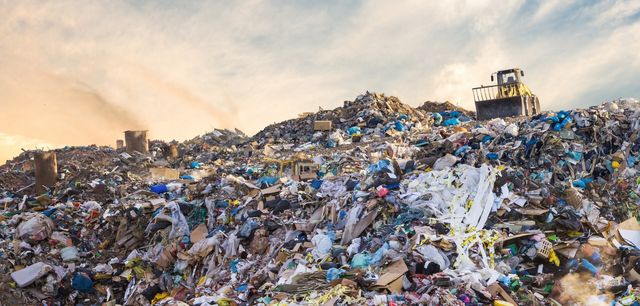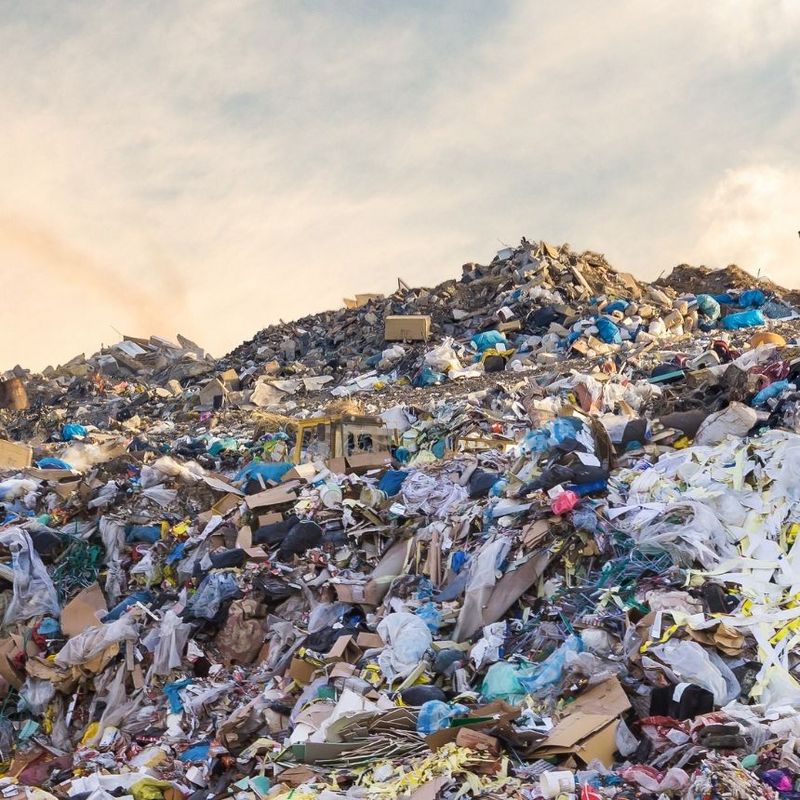30 January 2025
In 2023, an average of 433 kilogrammes of household waste was generated per person in Germany. This is equivalent to the weight of four fattening pigs. Human beings have been generating significant amounts of waste ever since they started gathering in groups – and how to deal with that waste has been a major headache for many centuries. This brief history of waste relates how and when waste became a global problem.
In the beginning there was waste. People have always thrown things away, but the volume of waste generated in this way was initially very modest. This is because early humans used almost every part of the animals they hunted: Their tendons were used to string bows, and their bones became the raw material for the carving of tools, jewellery or flutes. And, in the early human circular economy, new uses were sought and found as often and as long as possible, even for blunt flint knives or other worn-out tools. Only when they could no longer be used at all were they finally thrown away, generally being disposed of where people happened to be staying anyway.
Urbanisation and rubbish
The principle of leaving your waste where it falls works as long as people live nomadically, moving from place to place. But as our ancestors settled down, waste became a problem that needed to be taken care of. In smaller settlements or villages, you can feed food scraps to animals and fertilise the fields with what they and you yourselves produce. But the more densely packed people live in towns and cities, the more rubbish is generated that somehow needs to be carted away.
Public venues
In ancient Rome, it was the responsibility of the “aediles” to check the condition of squares and streets and to remind homeowners who had “forgotten” to clean their house fronts of their duties. Waste and rubbish from the metropolis were channelled into the Tiber via a partially covered sewage system.
Anyone who was overcome by that all-too-human need while out and about could use a public toilet at little expense. Privacy was not necessarily a priority in the open-plan toilets with up to 80 seats, but many of them were at least equipped with water flushes. Human waste was transported out of the city via the sewers using the wastewater from the bathhouses to which many of the public utilities were connected.
© Adobe StockPublic toilets, also known as latrines: In ancient Rome, solutions were created for the inhabitants and their human waste.
© Adobe StockEarly human tools were based on the conviction and need to use everything from animals - so there was hardly any rubbish.
Mountains of cast-off amphora fragments
The water that supplied these bathhouses and the public fountains was brought into the metropolis via aqueducts. In order to supply its residents, however, goods and food also needed to be brought in from near and, often, far away every single day and securely packaged for transport. In many cases, the amphora established itself as the staple of transport packaging. This was because these large clay jugs could be produced inexpensively and easily moulded to suit the various purposes for which they were intended.
Once the contents of the amphorae had been used up, the empties were not returned to the suppliers. This would not have made economic sense for the traders. Instead, grain or wine amphorae were reused as storage vessels, whereas other amphorae were smashed up and used in road and house construction. The ceramic containers for olive oil in particular were generally destroyed after a single use and disposed of as waste. This was because the olive oil would seep into the clay, where it would spoil and begin to smell.
The shards of what was probably the first disposable packaging in human history were transported to a natural depression near the banks of the Tiber. Over the years, a 50-metre-high hill with a circumference of one kilometre arose there, which archaeologists would later christen Monte Testaccio, the hill of fragments.
Stinking Middle Ages and valuable rags
When the Roman Empire fell, many of the attainments which had defined it as a civilisation were lost with it: Aqueducts and sewers fell into disrepair or were not even installed in new cities in the first place. Waste and faeces were dumped into rivers, pits or simply thrown out of the window, occasionally to be devoured by feral pigs which would then go on to produce their own waste.
The authorities gradually began to suspect that the probability of epidemics was increasing along with all the dirt and stench. Various municipalities prohibited their citizens from disposing of waste in the street and tried on occasion to compel them to clean it up – mostly with limited success. This was one of the reasons why the city of Wrocław introduced the prototype of a municipal refuse collection system as early as 1559.
This service was initially limited to food waste and excreta. This was because materials such as metal or fabric were far too valuable simply to be thrown away. New nails could be made from old iron, new clothes from scraps of fabric. Only when clothes were completely worn out would they be left for the rag collectors, who would then sell the rags to paper mills. This was a very lucrative business; after all, fabric fibres had for centuries been the only raw material used in making paper. This did not change until the 19th century with the development of mechanical paper production from wood.
The sewer launches a comeback
Not only did the industrial revolution deprive rag pickers of their most lucrative source of income – it also drastically changed whole societies, virtually overnight. More and more people were flocking to the cities. And as the populations exploded, so too did the waste problem. Diseases such as typhoid, dysentery and cholera cost thousands of lives. It was for this reason, in 1858, that the authorities in London decided to build a modern sewer system. The largest civilian construction project of the 19th century became a model for other European metropolises, which also went on to launch waste collection systems for the first time, alongside their own sewage systems.
Plastic presents new opportunities
Supported by the new technical possibilities of industrialisation, more and more inventors directed their efforts at replacing expensive natural materials with artificially produced ones. In 1869, John Wesley Hyatt was granted a patent on celluloid, which became popular as an affordable substitute for ivory in jewellery and combs. In 1907, Leo Baekeland invented Bakelite, the first mass-produced synthetic plastic, which was used to make radios, telephone housings and light switches.
Spurred on by the shortage of raw materials imposed by the Second World War, research into inexpensive substitutes made of plastics intensified: Polyvinyl chloride, or PVC for short, was first produced on an industrial scale in the 1930s, followed in 1939 by polyethylene, which is now the most common plastic in the world.
By the 1950s, plastic reigned supreme. Plastics were cheap, light and strong; they could be cast or pressed into all kinds of shapes and thus found their way into more and more households. Instead of taking their groceries home from their local shops in containers or newspaper they had brought with them, people increasingly started shopping in supermarkets for goods packaged in plastic. Plastic packaging kept the food fresh for longer and was then thrown away, eliminating the need for the time-consuming chore of cleaning. This was a real relief for the housewife. The fact that the unprecedented durability of plastic was also a drawback would only become apparent over the next few decades.
Economic miracles and proliferating waste
Industrial production methods meant that other products were also getting cheaper, with some even becoming available for the first time. And with post-war economic growth, more people could afford more things than ever before. The amount of waste increased relentlessly. Landfills were springing up around towns and cities. The first waste incineration plants had started operating in Germany back in the 1890s, especially in metropolitan areas where there was limited space for landfills.
All too often, however, people still simply disposed of their waste out of doors. Fly tipping proliferated by the sides of roads, in gravel pits or woodlands, with household waste, refrigerators, industrial waste, waste oil and sometimes even cars being dumped, giving rise to soil and groundwater contamination.
With the Waste Disposal Act of 1972, politicians tried to put a stop to this uncontrolled growth in fly tipping. Waste was now to be stored in central, fenced-off refuse dumps. And yet, these landfill sites were still only lightly regulated. Only gradually were methods and standards developed to seal them so that their contaminants would be prevented from poisoning the environment.
© Adobe StockCheap, light, robust: after 1050, plastic became increasingly popular - with far-reaching consequences that can still be felt today.
© Adobe StockMore economic power, more purchases. And in the post-war period, the mountains of rubbish also grew. Waste was often disposed of carelessly.
Recycling rediscovered
With the environmental movement and the various oil price crises, awareness began to grow both of the waste problem and of the finite nature of natural resources, along with the realisation that waste still contained valuable natural resources. In 1974, Hanover became the first city in the Federal Republic of Germany to install a waste glass container – thereby laying the foundation for waste separation in Germany. Starting in 1984, the first wastepaper containers followed in German municipalities. In the same year, a student initiative in Würzburg installed the first organic waste bins.
But what about the ubiquitous plastic? With the German Packaging Ordinance of 1991, politicians declared for the first time that the manufacturers would be held accountable: From that date on, they were required to take back their packaging and arrange for its disposal or recycling themselves – thereby giving birth to the “Grüner Punkt”, or “green dot”.
51 percent of plastic packaging waste is now recycled in Germany. Although Germany’s plastic recycling rate was above the EU average of 41 percent in 2022, it still only managed a respectable fifth place. So, there is still a lot of room for improvement – especially since the volume of plastic waste has increased more steeply throughout the EU in the last ten years than the proportion which gets recycled.
Plastic eaters put to the test
Plastic eaters put to the test
Plastic remains a global problem: 3.4 percent of global CO2 emissions were caused by plastics in 2019, and millions and millions of tons of plastic end up in soils, rivers and oceans every year.
Researchers around the world are experimenting with special bacteria that attack plastic. But the extent to which microorganisms can help us with our waste problem is far from clear.
Along with increasing the consistency of recycling, the only remaining option is to generate less waste. This is a development that the EU aims to accelerate through ever higher recycling rates, a ban on single-use plastic and the “right to repair”.
© Adobe StockWaste separation is not practised in Germany until after 1974. The first waste paper containers were installed in 1984.
© Adobe StockRecycling rates are consistently increasing in the EU - ultimately, however, the aim is for consumers to produce as little waste as possible.









